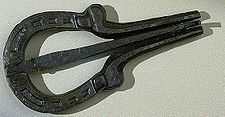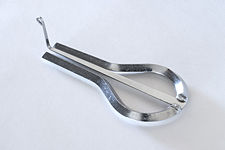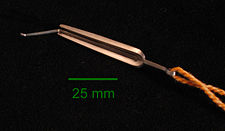- Jew's harp
-
The Jew's harp, jaw harp, mouth harp, Ozark harp, trump or juice harp, is thought to be one of the oldest musical instruments in the world;[1] a musician apparently playing it can be seen in a Chinese drawing from the 4th century BC.[2] Despite its common English name, and the sometimes used Jew's trump, it has no particular connection with the Jewish people or Judaism. This instrument is native to Asia and used in all tribes of Turkic peoples in Asia where it is variously referred to as a temir komuz (literally, iron komuz), agiz komuzu (literally, mouth komuz) or gubuz.
The instrument is known in many different cultures by many different names. The common English name "Jew's harp" may be considered controversial or potentially misleading, and is thus avoided by some speakers. Another name used to identify the instrument, especially in scholarly literature, is the older English trump, while guimbarde, the French word for the instrument, can be found in unabridged dictionaries and is featured in recent revival efforts.
The instrument is a lamellophone, which is in the category of plucked idiophones: it consists of a flexible metal or bamboo tongue or reed attached to a frame. The tongue/reed is placed in the performer's mouth and plucked with the finger to produce a note. The frame is held firmly against the performer's parted front teeth, using the jaw (thus "jaw harp") and mouth as a resonator, greatly increasing the volume of the instrument. The teeth must be parted sufficiently for the reed to vibrate freely, and the fleshy parts of the mouth should not come into contact with the reed to prevent damping of the vibrations. The note thus produced is constant in pitch, though by changing the shape of his or her mouth and the amount of air contained in it (and in some traditions closing the glottis) the performer can cause different overtones to sound and thus create melodies. The volume of the note can be varied by breathing in and out.
Since trances are facilitated by droning sounds,[3] the Jew's harp has been associated with magic and has been a common instrument in shamanic rituals.[4]
The temir komuz is made of iron usually with a length of 100- 200mm and with a width of approximately 2- 7mm. The range of the instrument varies with the size of the instrument, but generally hovers around an octave span. The Kirgiz people are unusually proficient on the temir komuz instrument and it is quite popular among children. However, some adults continue to play the instrument. There is a National Artist of Kyrgyz Republic who performs on the instrument, temir komuz. One time twenty Kirgiz girls played in a temir komuz ensemble on the stage of the Bolshoi Theater in Moscow. Temir komuz pieces was notated by Zataevich in two or three parts. Apparently an octave drone is possible, or even an ostinato alternating the fifth step of a scale with an octave.[5]
Contents
Etymology
There are many theories for the origin of the name Jew's harp. One proposed explanation is that it is a corruption of "jaws harp", while a less likely explanation espoused by some is that its name comes from "juice harp" from the amount of saliva produced when played by inexperienced players. While the "jaw" variant is attested at least as early as 1774[6] and 1809 [7], the "juice" variant appeared only in the late 19th and 20th centuries. It has also been suggested that the name derives from the French "Jeu-trompe" meaning "toy-trumpet".[8]
The Oxford English Dictionary calls theories that the name is a corruption of "jaws" or "jeu" "baseless and inept" and goes on to say, "More or less satisfactory reasons may be conjectured: e.g. that the instrument was actually made, sold, or sent to England by Jews, or supposed to be so; or that it was attributed to them, as a good commercial name, suggesting the trumps and harps mentioned in the Bible."[9]
Use
Turkic traditional music
The instrument is also used by Sakha or Yakut people and Tuvanss with the name xomus.
Sindhi music
In Sindhi the Jaw harp is called Changu (چنگُ). In Sindhi music, it can be an accompaniment or the main instrument. One of the most famous players is Amir Bux Ruunjho.[10]
World music
The Jew's harp is frequently to be found in the repertoire of music played by alternative or world music bands. Sandy Miller of the UK-based Brazilian samba/funk band Tempo Novo, plays a Jew's harp solo in the piece Canto de Ossanha.[11]
Western Classical Music
The Austrian composer Johann Albrechtsberger—chiefly known today as a teacher of Beethoven—wrote several concerti for Jew's harp in the mid-1760s.[12]
See also
- Morsing, a kind of Jew's harp from India
- Đàn môi another kind of Jew's harp from Vietnam
- Gogona, a similar instrument played by Assamese people (especially women) while singing and dancing Bihu
- Music of Central Asia
- Music of Sicily
- Temir komuz
- Agiz komuzu
- Gubuz
References
Notes
- ^ "Sicilian Item of the day : Marranzano". Siciliamo (blog). 2007-08-10. http://siciliamo.blogspot.com/2007/08/sicilian-item-of-day-marranzano.html. Retrieved 2008-02-20.
- ^ http://www.silkroadfoundation.org/newsletter/vol2num2/Harp.htm
- ^ The Body of Myth: Mythology, Shamanic Trance, and the Sacred, by J. Nigro Sansanese. http://books.google.com.au/books?id=aUZBqTKTAfIC&pg=PA117&lpg=PA117&dq=trances+facilitated+by+droning+sounds&ct=result#PPA117,M1.
- ^ http://www.3worlds.co.uk/Pages/Gallery-4-Ritual.html
- ^ Kirgiz Instrumental Music Author: Mark Slobin http://books.google.com.tr/books?id=uIRnaq0_Il8C&lpg=PA20&ots=v-kM-y4zCq&dq=temir%20komuz&pg=PA20#v=onepage&q=temir%20komuz&f=false
- ^ Muiscellaneous and Fugitive pieces, vol3, Johnson et al. 1774
- ^ Pegge's Anonymiana, 1818, p 33
- ^ Timbs, John (1858). Things Not Generally Known: Popular Errors Explained & Illustrated. p. 61.
- ^ "Jews' trump, Jew's-trump". Oxford English Dictionary. Oxford University Press. 1989.
- ^ Sindhi Changu
- ^ MySpace.com - Tempo Novo - Leamington Spa, UK - Latine / Jazz / Tropicale - www.myspace.com/temponovo
- ^ Albrechtsberger: Concerto for Jew's Harp, Amazon CD Listing (Munich Chamber Orchestra, December 19, 1992)
Bibliography
- Alekseev, Ivan, and E. I. [i.e. Egor Innokent'evich] Okoneshnikov (1988). Iskusstvo igry na iakutskom khomuse. IAkutsk: Akademiia nauk SSSR, Sibirskoe otd-nie, IAkutskii filial, In-t iazyka, lit-ry i istorii.
- Bakx, Phons (1992). De gedachtenverdrijver: de historie van de mondharp. Hadewijch wereldmuziek. Antwerpen: Hadewijch. ISBN 90-5240-163-2.
- Boone, Hubert, and René de Maeyer (1986). De Mondtrom. Volksmuziekinstrumenten in Belgie en in Nederland. Brussel: La Renaissance du Livre.
- Crane, Frederick (1982). "Jew's (jaw's? jeu? jeugd? gewgaw? juice?) harp." In: Vierundzwanzigsteljahrschrift der Internationalen Maultrommelvirtuosengenossenschaft, vol. 1 (1982). With: "The Jew's Harp in Colonial America," by Brian L. Mihura.
- Crane, Frederick (2003). A History of the Trump in Pictures: Europe and America. A special supplement to Vierundzwanzigsteljahrsschrift der Internationalen Maultrommelvirtuosengenossenschaft. Mount Pleasant, Iowa: [Frederick Crane].[1]
- Dournon-Taurelle, Geneviève, and John Wright (1978). Les Guimbardes du Musée de l'homme. Preface by Gilbert Rouget. Published by the Muséum national d'histoire naturelle and l'Institut d'ethnologie.
- Emsheimer, Ernst (1941). "Uber das Vorkommen und die Anwendungsart der Maultrommel in Sibirien und Zentralasien." Ethnos (Stockholm), nos 3-4 (1941).
- Emsheimer, Ernst (1964). "Maultrommeln in Sibierien und Zentralasien." In Studia ethnomusicologica eurasiatica (Stockholm: Musikhistoriska museet, pp. 13–27).
- Fox, Leonard (1984). The Jew's Harp: A Comprehensive Anthology. Selected, edited, and translated by Leonard Fox. Charleston, South Carolina: L. Fox.
- Fox, Leonard (1988). The Jew's Harp: A Comprehensive Anthology. Selected, edited, and translated by Leonard Fox. Lewisburg: Bucknell University Press; London: Associated University Presses. ISBN 0-8387-5116-4.
- Gallmann, Matthew S. (1977). The Jews Harp: A Select List of References With Library of Congress Call Numbers. Washington, D.C.: Library of Congress, Archive of Folk Song.
- Gotovtsev, Innokenty. New Technologies for Yakut Khomus. Yakutsk.[2]
- Kolltveit, Gjermund (2006). Jew's Harps in European Archaeology. BAR International series, 1500. Oxford, England: Archaeopress. ISBN 1-84171-931-5.
- Plate, Regina (1992). Kulturgeschichte der Maultrommel. Orpheus-Schriftenreihe zu Grundfragen der Musik, Bd. 64. Bonn: Verlag für Systematische Musikwissenschaft. ISBN 3-922626-64-5.
- Shishigin, S. S. (1994). Igraite na khomuse. Mezhdunarodnyi tsentr khomusnoi (vargannoi) muzyki. Pokrovsk : S.S. Shishigin/Ministerstvo kul'tury Respubliki Sakha (IAkutiia). ISBN 5-85157-012-1.
- Shishigin, Spiridon. Kulakovsky and Khomus. Yakutia.[3]
- Smeck, Roy (1974). Mel Bay's Fun With the Jaws Harp.[4]
- Wright, Michael (2008) The Jew's Harp in the Law, 1590-1825 Folk Music Journal 9.3 pp349–371 ISSN 0531-9684
- Yuan, Bingchang, and Jizeng Mao (1986). Zhongguo Shao Shu Min Zu Yue Qi Zhi. Beijing : Xin Shi Jie Chu Ban She: Xin Hua Shu Dian Beijing Fa Xing Suo Fa Xing. ISBN 7-80005-017-3.
External links
- Hawaiian Jew's Harp The 'Ukeke, Indigenous Hawaiian string instrument played with the mouth, sound clips.
- The Jew's Harp Guild
- How to play the jew's harp (instructions with sound examples and remarks on the functioning of Jew's harps)
- A page on guimbardes from Pat Missin's free reed instrument website
- Origins of the Jew's Harp. A popular synopsis of the archaeological findings of Jew's harps combined with an extensive illustrated survey of the world distribution of different types.
- Jewsharper Jews harp history, news and tutorials from Michael Wright, of Oxfordshire, UK
- Demir-xomus (Tuvan Jew's Harp) Demos, photos, folktale, and text
Categories:- Early musical instruments
- Lamellophones
- Appalachian culture
- Italian musical instruments
- Slovenian musical instruments
- Hungarian musical instruments
- Tuvan musical instruments
- Mongolian musical instruments
- Kazakhstani musical instruments
- Uzbekistani musical instruments
- Kyrgyz musical instruments
Wikimedia Foundation. 2010.




